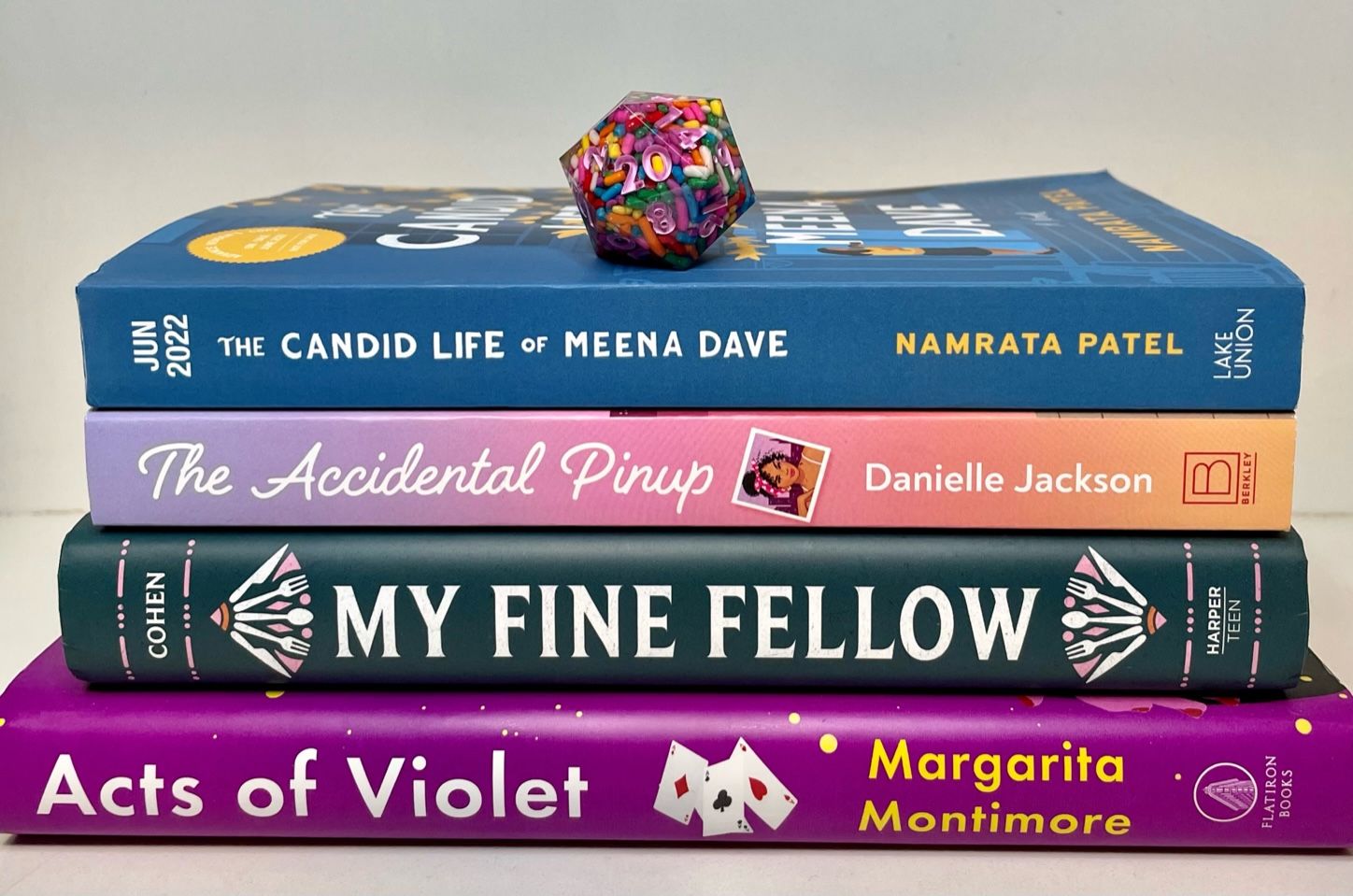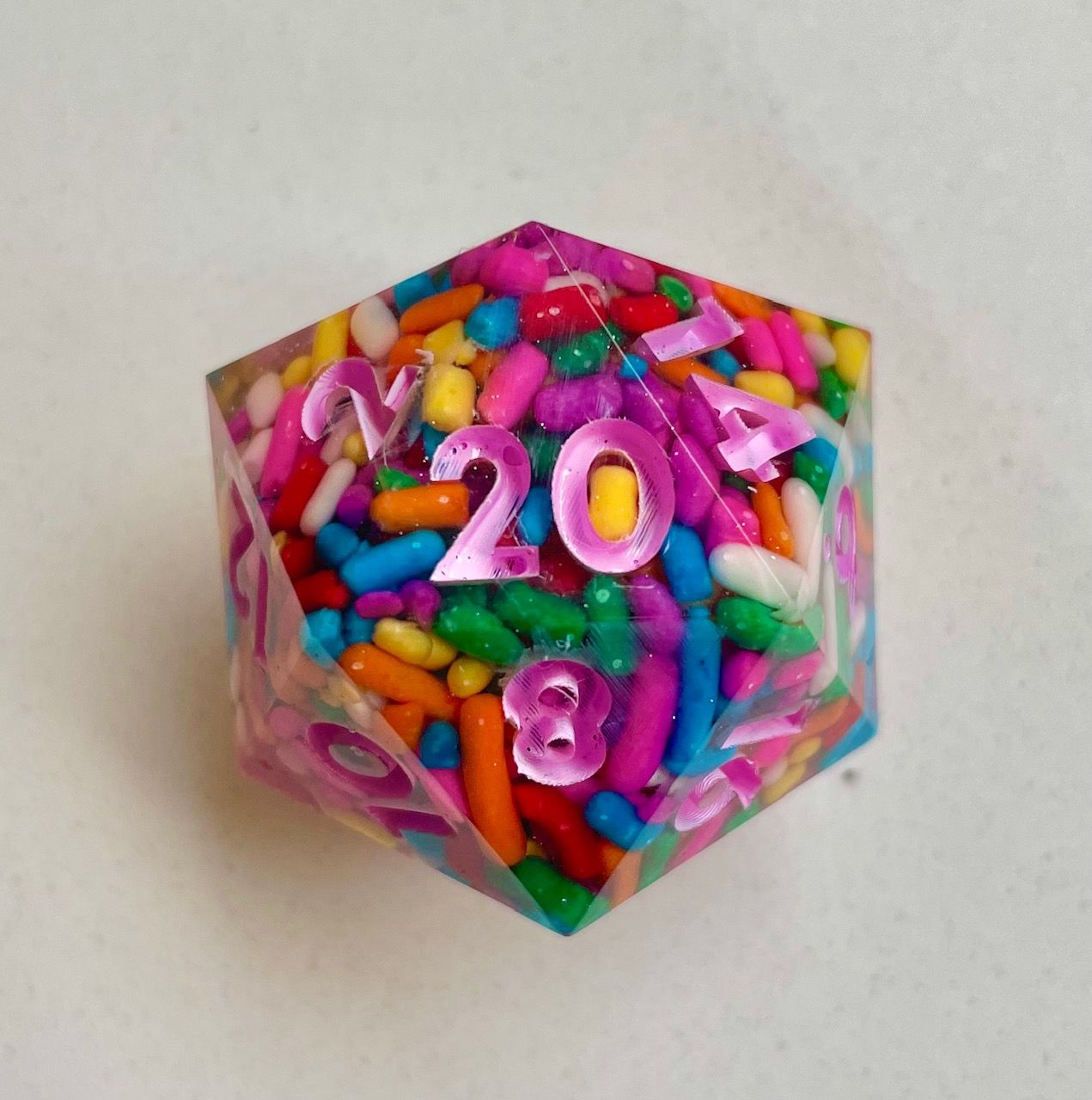It all started when my wife found a new hobby. (Well, technically, the TBR problem started decades before that, when I first started hoarding books.) My wife has a recently reignited love of Dungeons and Dragons, or D&D if you’re in the know. After joining a virtual D&D campaign with some friends, she decided to figure out how to make her own dice sets using resin. I’m not personally a D&D fan, but as I understand it, a typical set of dice for the tabletop roleplaying game includes six different die shapes with varying numbers of faces: 4, 6, 8, 10, 12, and the signature D&D die with 20 faces. Making D&D dice at home is, from my observation, an intricate and multi-step process. But when it comes to what you can put in the resin to make a set of dice unique, the sky is the limit. After watching my wife play around with different colors and add-ins, I asked her to make me a 20-sided die (or D20) filled with sprinkles. She did! And it’s so cute! I love it so much! But, as mentioned earlier…I don’t play D&D. So what was I to do with my adorable little die? Use it as a tiny paperweight? Convince the cat to play with it? Turn it into a brooch? Then I thought of something in my life that could use a little game of luck and chance: the aforementioned towering TBR. What if I used my D20 to help me choose what book to read next? Convinced my idea was completely original, I decided to make a list of 20 books on my TBR and roll the die to pick my next read. My wife later informed me that “roll tables” are in fact a fairly common thing in and out of D&D games. There’s even a TikTok user who has gone viral for making chaotic sandwiches using dice to select his ingredients. Although mine wasn’t as original an idea as initially thought, I boldly went forward with my D20, my giant stack of books, and a dream. Here’s what I learned.
Using Dice for Multiple TBR Formats
Before I even began, I realized creating a roll table could be useful for more than just my physical stack of unread books. I’m typically in the middle of three books at any given moment: a print book, an ebook, and an audiobook. And I have a backlog of books in all three categories. (What’s my secret to having so many books at my disposal, you ask? Well, one of the benefits to writing for Book Riot for 5+ years is infinite advanced copies from publishers.) So I created three roll tables for my game of reading chance. One list included 20 titles from my overcrowded bookshelf of physical copies of unread books. For the second, I pulled 20 of the…yeah, okay, hundreds of unread ebooks on my Kindle. The vast majority of these came to me via NetGalley, a site booksellers, librarians, and book reviewers use to access digital advanced copies of books. For my third list, I went to Libro.fm, an audiobook platform that splits the proceeds with independent bookstores, and pulled titles from my to-be-listened shelf. This way, when rolling the die for my next read, I can leave the book up to chance while still choosing a specific format. If you want to recreate this experiment at home, you can use a fully random list of 20 books across different formats. But for me, when I set out to start a new book, I already know what format I’m looking for. There’s definitely value to both!
Reflecting While Making the Roll Table
The first unexpected benefit to my experiment was thoughtfully and honestly reflecting on my TBR. When sitting down to make a list of 20 potential reads from my bookshelf, I had to face the facts. I could only fit 20 books on this roll table, and some of the books on my shelf simply didn’t excite me. Assigning many of the books a number gave me hope that I’d finally get to them. I’ve been staring down Docile by K.M. Szpara for years now, eager to dig in but intimidated by its length. Maybe now the die would give me the sign I needed to crack it open. But I hesitated to give some of the books on my shelf a spot on my list. I realized that this was a sign. If even the idea of the die landing on that title disappointed me, I likely wouldn’t ever get around to that book. I think this had similar energy to Marie Kondo’s “sparking joy” principle. If the possibility of reading a book on my shelf didn’t excite me, it was time to let it go. Simply making my list of 20 potential reads gave me the courage to weed books from my physical TBR. This is a great tool for facing down unread books across formats. If the idea of reading that book now or even in the near future has you feeling meh, it’s time to say goodbye! Maybe you bought that book a few years ago when you were in a different place and it no longer interests you. That’s okay. I’m planning to take a similar approach to my TBR Goodreads shelf. Some of the books on that list have been hanging out there for almost a decade. And as for my ebooks from NetGalley, it’s probably time to try that new “I will not be giving feedback on this title” option.
When the Dice Roll Just Right
Once my roll tables were made, it was time to give it a try. My first roll directed me to the recently republished version of Rules of Engagement by Selena Montgomery, a.k.a. Stacey Abrams. Great! I’d been wanting to read one of her political romantic thrillers for years. Thanks, D20, for giving me the prompt I needed. I used the die again shortly afterwards to pick my next audiobook. It chose My Monticello, a short story collection from Jocelyn Nicole Johnson. Awesome! I didn’t even realize that the first story was narrated by LeVar Burton. Thanks, D20, for pushing me to choose something that had otherwise fallen into the backlist. The D20 chance method isn’t how I’ve decided every new book I’ve picked up since I first started this experiment. Sometimes I need to push a book to the top of my TBR for Book Riot or other professional purposes. Other times, I’m looking for a specific genre or vibe to fit my mood. Occasionally I acquire a book that I have to drop everything and read immediately. But I think using dice intermittently to determine my next read is a great way to mix things up.
When the Dice Roll Doesn’t Fit
Here’s another unexpected benefit I found from my experiment: Sometimes the dice tell you what you already know deep down. There were a few occasions when I rolled my beautiful D20 and as soon as I saw what book it turned up, I knew I didn’t want to read it. At first, this felt like a bad thing. Oh no, my chance game sucks! It gave me a book I don’t want to read! But this, too, is a gift. If my gut feeling in that moment is, “I don’t want to read that,” then…get rid of the book. It’s kind of like when you’re flipping a coin and while the coin is in the air, it suddenly doesn’t matter where it lands because you realize what you wanted all along. Of course, it didn’t always work that way. One time the die landed on a horror novel right after I’d finished another book in the same genre. I still wanted to read that book, but I needed a palate cleanser before I could face more thrills and chills. That book stayed on my roll table for its number to come up again on another day.
Let the Good Books Roll
After trying my D20 method out on my TBR, I found many benefits, both expected and unexpected. As I hoped, my die inspired me to try out books that might have otherwise spent years collecting dust on my shelves. It helped me select some unexpected books from my digital and audiobook backlists. But even better, it helped me let books go. I’m terrible about keeping books around for years, unable to admit I won’t get to them. Those books could find a better home if gifted to friends, donated to the library, or dropped on a “take a book, leave a book” shelf in a public space. I was able to be more honest with myself about my reading time when faced with those books while making my roll tables, and again for other books when the die landed on their numbers. The immediacy of rolling my D20 — of chance telling me it’s now or never(ish) — made it much easier to purge titles from my collection. If you, too, have a stack of unread books gathering dust in your home, I highly recommend giving this a try. You don’t even need dice to get started, as there are plenty of free dice rollers online. But having your own dice is a lot more satisfying. You can use the more common six-sided die if you have one on hand, and makes lists of six books instead of 29. Or, if you don’t have a wife to make custom dice for you, you can find handmade dice of all kinds on Etsy. May bookish chance roll in your favor! You might also enjoy: The Best Dungeons and Dragons Accessories for Your Next Campaign Manage Your TBR with These Reading List Apps The Art and Therapeutic Act of Weeding Your Digital Shelves

